Management Strategies for Starbucks and Tesco in Competitive Markets
VerifiedAdded on 2023/04/23
|8
|1445
|103
AI Summary
This article discusses the issues faced by Starbucks and Tesco in competitive markets and provides recommendations to address them. It also includes Porter's Generic Forces and Hofstede's Model of Cultural Dimension.
Contribute Materials
Your contribution can guide someone’s learning journey. Share your
documents today.
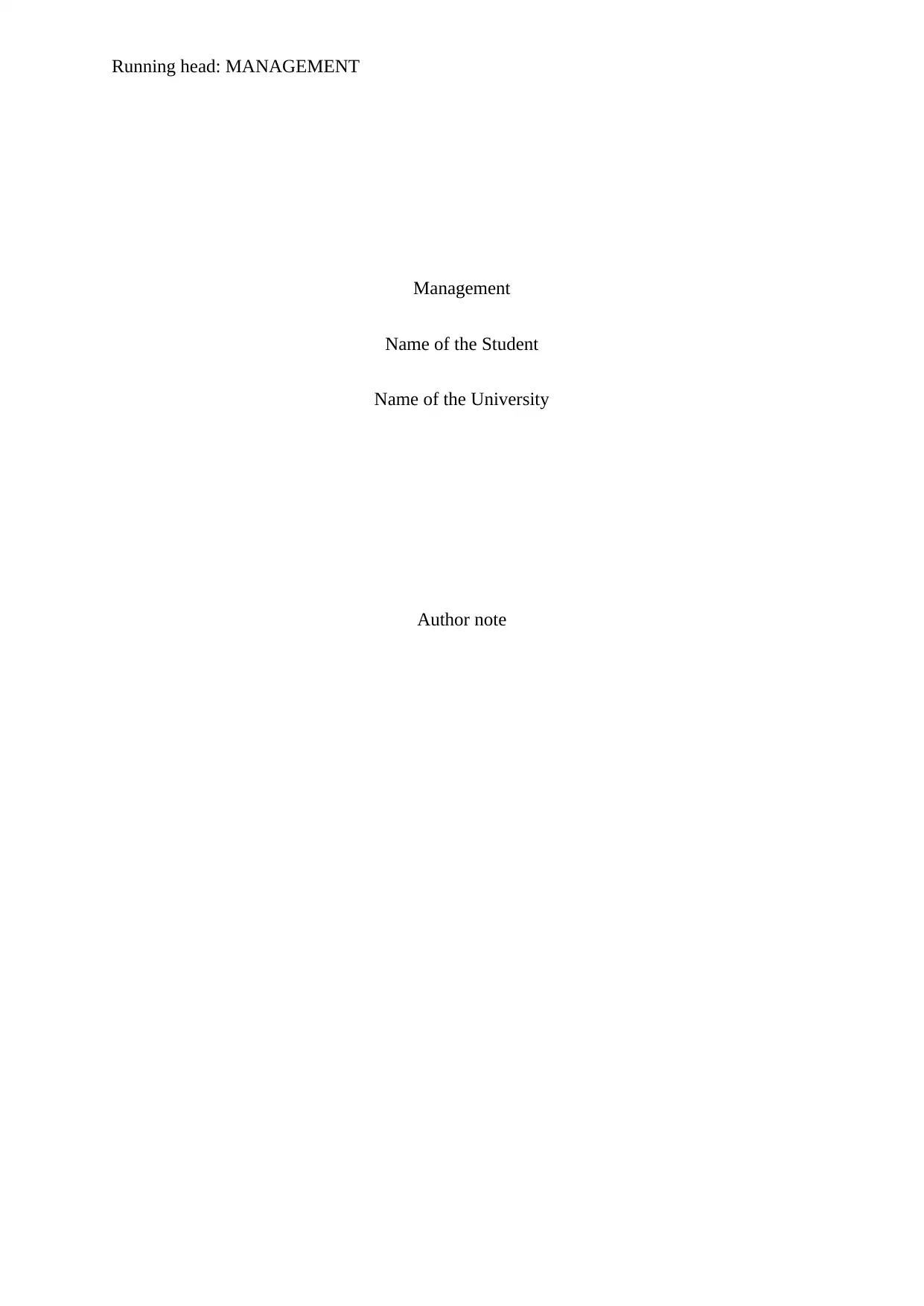
Running head: MANAGEMENT
Management
Name of the Student
Name of the University
Author note
Management
Name of the Student
Name of the University
Author note
Secure Best Marks with AI Grader
Need help grading? Try our AI Grader for instant feedback on your assignments.
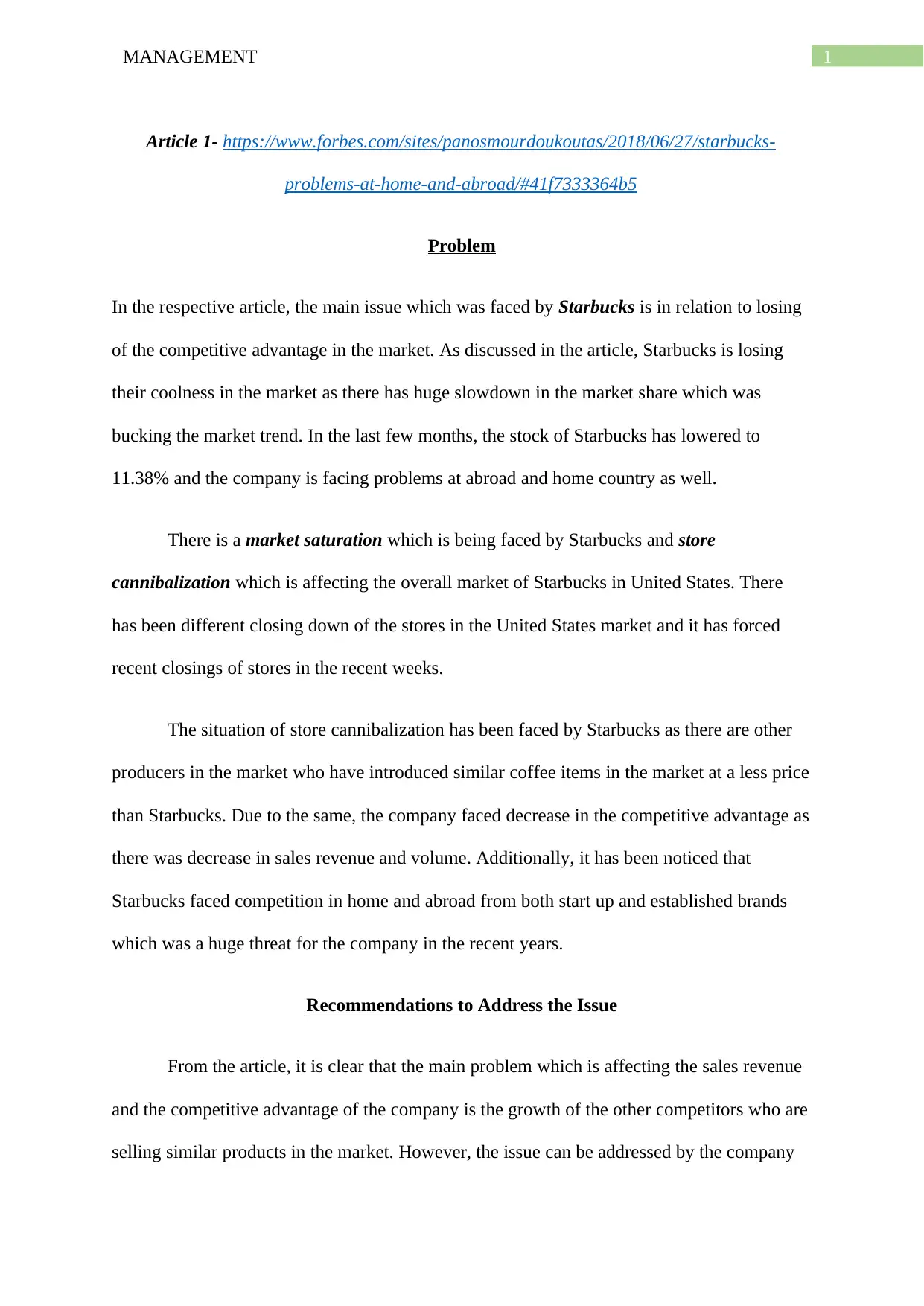
1MANAGEMENT
Article 1- https://www.forbes.com/sites/panosmourdoukoutas/2018/06/27/starbucks-
problems-at-home-and-abroad/#41f7333364b5
Problem
In the respective article, the main issue which was faced by Starbucks is in relation to losing
of the competitive advantage in the market. As discussed in the article, Starbucks is losing
their coolness in the market as there has huge slowdown in the market share which was
bucking the market trend. In the last few months, the stock of Starbucks has lowered to
11.38% and the company is facing problems at abroad and home country as well.
There is a market saturation which is being faced by Starbucks and store
cannibalization which is affecting the overall market of Starbucks in United States. There
has been different closing down of the stores in the United States market and it has forced
recent closings of stores in the recent weeks.
The situation of store cannibalization has been faced by Starbucks as there are other
producers in the market who have introduced similar coffee items in the market at a less price
than Starbucks. Due to the same, the company faced decrease in the competitive advantage as
there was decrease in sales revenue and volume. Additionally, it has been noticed that
Starbucks faced competition in home and abroad from both start up and established brands
which was a huge threat for the company in the recent years.
Recommendations to Address the Issue
From the article, it is clear that the main problem which is affecting the sales revenue
and the competitive advantage of the company is the growth of the other competitors who are
selling similar products in the market. However, the issue can be addressed by the company
Article 1- https://www.forbes.com/sites/panosmourdoukoutas/2018/06/27/starbucks-
problems-at-home-and-abroad/#41f7333364b5
Problem
In the respective article, the main issue which was faced by Starbucks is in relation to losing
of the competitive advantage in the market. As discussed in the article, Starbucks is losing
their coolness in the market as there has huge slowdown in the market share which was
bucking the market trend. In the last few months, the stock of Starbucks has lowered to
11.38% and the company is facing problems at abroad and home country as well.
There is a market saturation which is being faced by Starbucks and store
cannibalization which is affecting the overall market of Starbucks in United States. There
has been different closing down of the stores in the United States market and it has forced
recent closings of stores in the recent weeks.
The situation of store cannibalization has been faced by Starbucks as there are other
producers in the market who have introduced similar coffee items in the market at a less price
than Starbucks. Due to the same, the company faced decrease in the competitive advantage as
there was decrease in sales revenue and volume. Additionally, it has been noticed that
Starbucks faced competition in home and abroad from both start up and established brands
which was a huge threat for the company in the recent years.
Recommendations to Address the Issue
From the article, it is clear that the main problem which is affecting the sales revenue
and the competitive advantage of the company is the growth of the other competitors who are
selling similar products in the market. However, the issue can be addressed by the company
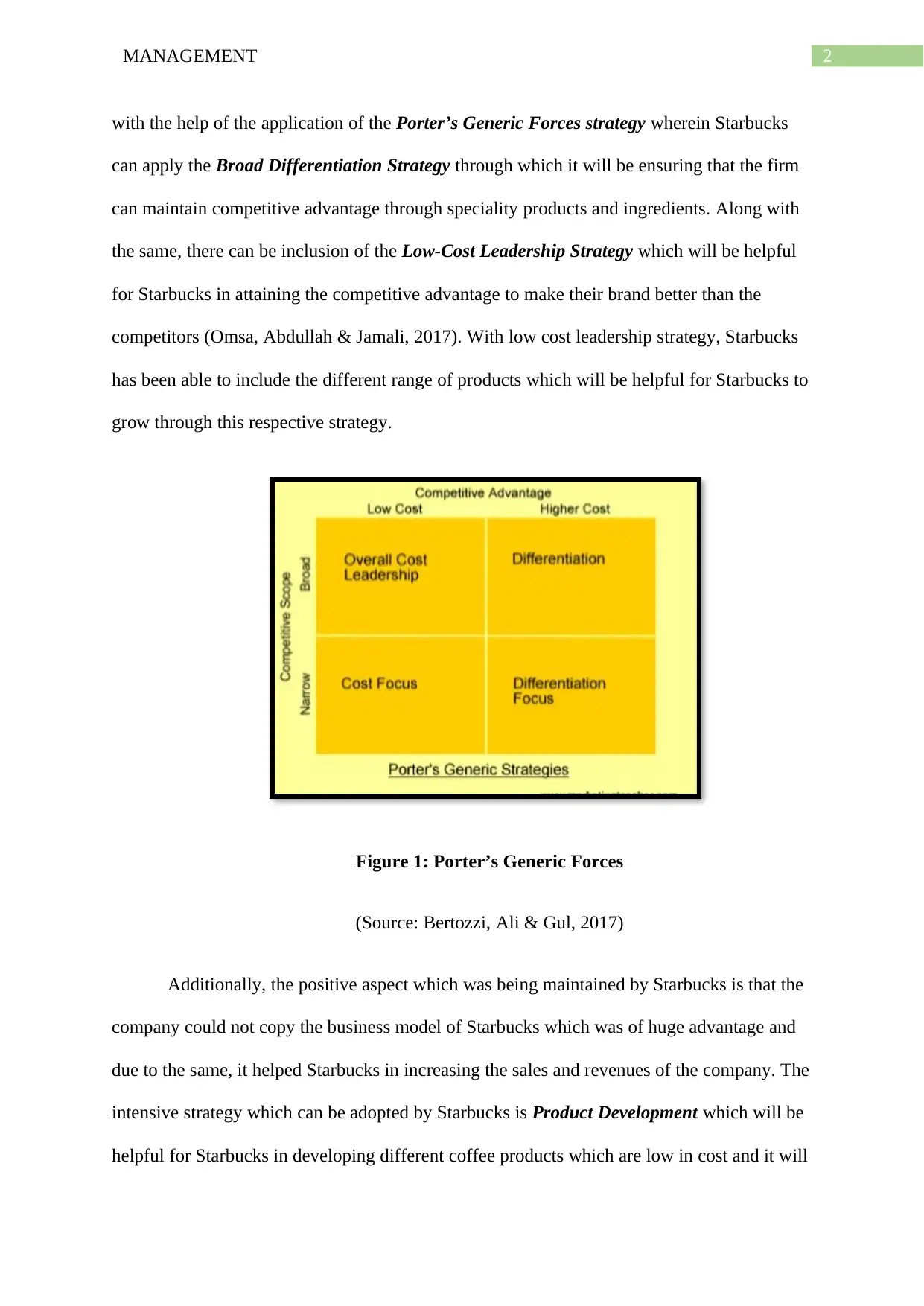
2MANAGEMENT
with the help of the application of the Porter’s Generic Forces strategy wherein Starbucks
can apply the Broad Differentiation Strategy through which it will be ensuring that the firm
can maintain competitive advantage through speciality products and ingredients. Along with
the same, there can be inclusion of the Low-Cost Leadership Strategy which will be helpful
for Starbucks in attaining the competitive advantage to make their brand better than the
competitors (Omsa, Abdullah & Jamali, 2017). With low cost leadership strategy, Starbucks
has been able to include the different range of products which will be helpful for Starbucks to
grow through this respective strategy.
Figure 1: Porter’s Generic Forces
(Source: Bertozzi, Ali & Gul, 2017)
Additionally, the positive aspect which was being maintained by Starbucks is that the
company could not copy the business model of Starbucks which was of huge advantage and
due to the same, it helped Starbucks in increasing the sales and revenues of the company. The
intensive strategy which can be adopted by Starbucks is Product Development which will be
helpful for Starbucks in developing different coffee products which are low in cost and it will
with the help of the application of the Porter’s Generic Forces strategy wherein Starbucks
can apply the Broad Differentiation Strategy through which it will be ensuring that the firm
can maintain competitive advantage through speciality products and ingredients. Along with
the same, there can be inclusion of the Low-Cost Leadership Strategy which will be helpful
for Starbucks in attaining the competitive advantage to make their brand better than the
competitors (Omsa, Abdullah & Jamali, 2017). With low cost leadership strategy, Starbucks
has been able to include the different range of products which will be helpful for Starbucks to
grow through this respective strategy.
Figure 1: Porter’s Generic Forces
(Source: Bertozzi, Ali & Gul, 2017)
Additionally, the positive aspect which was being maintained by Starbucks is that the
company could not copy the business model of Starbucks which was of huge advantage and
due to the same, it helped Starbucks in increasing the sales and revenues of the company. The
intensive strategy which can be adopted by Starbucks is Product Development which will be
helpful for Starbucks in developing different coffee products which are low in cost and it will
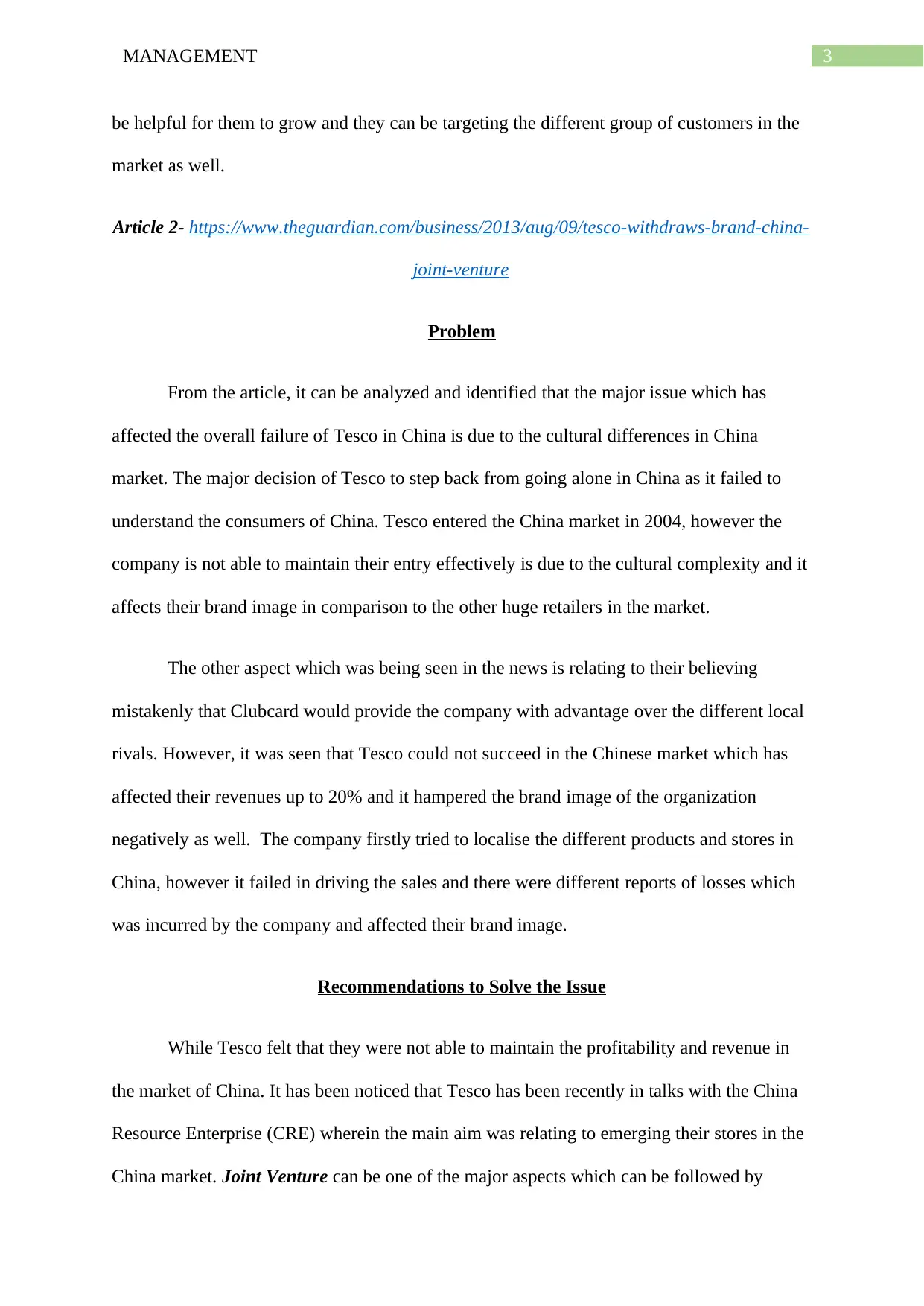
3MANAGEMENT
be helpful for them to grow and they can be targeting the different group of customers in the
market as well.
Article 2- https://www.theguardian.com/business/2013/aug/09/tesco-withdraws-brand-china-
joint-venture
Problem
From the article, it can be analyzed and identified that the major issue which has
affected the overall failure of Tesco in China is due to the cultural differences in China
market. The major decision of Tesco to step back from going alone in China as it failed to
understand the consumers of China. Tesco entered the China market in 2004, however the
company is not able to maintain their entry effectively is due to the cultural complexity and it
affects their brand image in comparison to the other huge retailers in the market.
The other aspect which was being seen in the news is relating to their believing
mistakenly that Clubcard would provide the company with advantage over the different local
rivals. However, it was seen that Tesco could not succeed in the Chinese market which has
affected their revenues up to 20% and it hampered the brand image of the organization
negatively as well. The company firstly tried to localise the different products and stores in
China, however it failed in driving the sales and there were different reports of losses which
was incurred by the company and affected their brand image.
Recommendations to Solve the Issue
While Tesco felt that they were not able to maintain the profitability and revenue in
the market of China. It has been noticed that Tesco has been recently in talks with the China
Resource Enterprise (CRE) wherein the main aim was relating to emerging their stores in the
China market. Joint Venture can be one of the major aspects which can be followed by
be helpful for them to grow and they can be targeting the different group of customers in the
market as well.
Article 2- https://www.theguardian.com/business/2013/aug/09/tesco-withdraws-brand-china-
joint-venture
Problem
From the article, it can be analyzed and identified that the major issue which has
affected the overall failure of Tesco in China is due to the cultural differences in China
market. The major decision of Tesco to step back from going alone in China as it failed to
understand the consumers of China. Tesco entered the China market in 2004, however the
company is not able to maintain their entry effectively is due to the cultural complexity and it
affects their brand image in comparison to the other huge retailers in the market.
The other aspect which was being seen in the news is relating to their believing
mistakenly that Clubcard would provide the company with advantage over the different local
rivals. However, it was seen that Tesco could not succeed in the Chinese market which has
affected their revenues up to 20% and it hampered the brand image of the organization
negatively as well. The company firstly tried to localise the different products and stores in
China, however it failed in driving the sales and there were different reports of losses which
was incurred by the company and affected their brand image.
Recommendations to Solve the Issue
While Tesco felt that they were not able to maintain the profitability and revenue in
the market of China. It has been noticed that Tesco has been recently in talks with the China
Resource Enterprise (CRE) wherein the main aim was relating to emerging their stores in the
China market. Joint Venture can be one of the major aspects which can be followed by
Secure Best Marks with AI Grader
Need help grading? Try our AI Grader for instant feedback on your assignments.
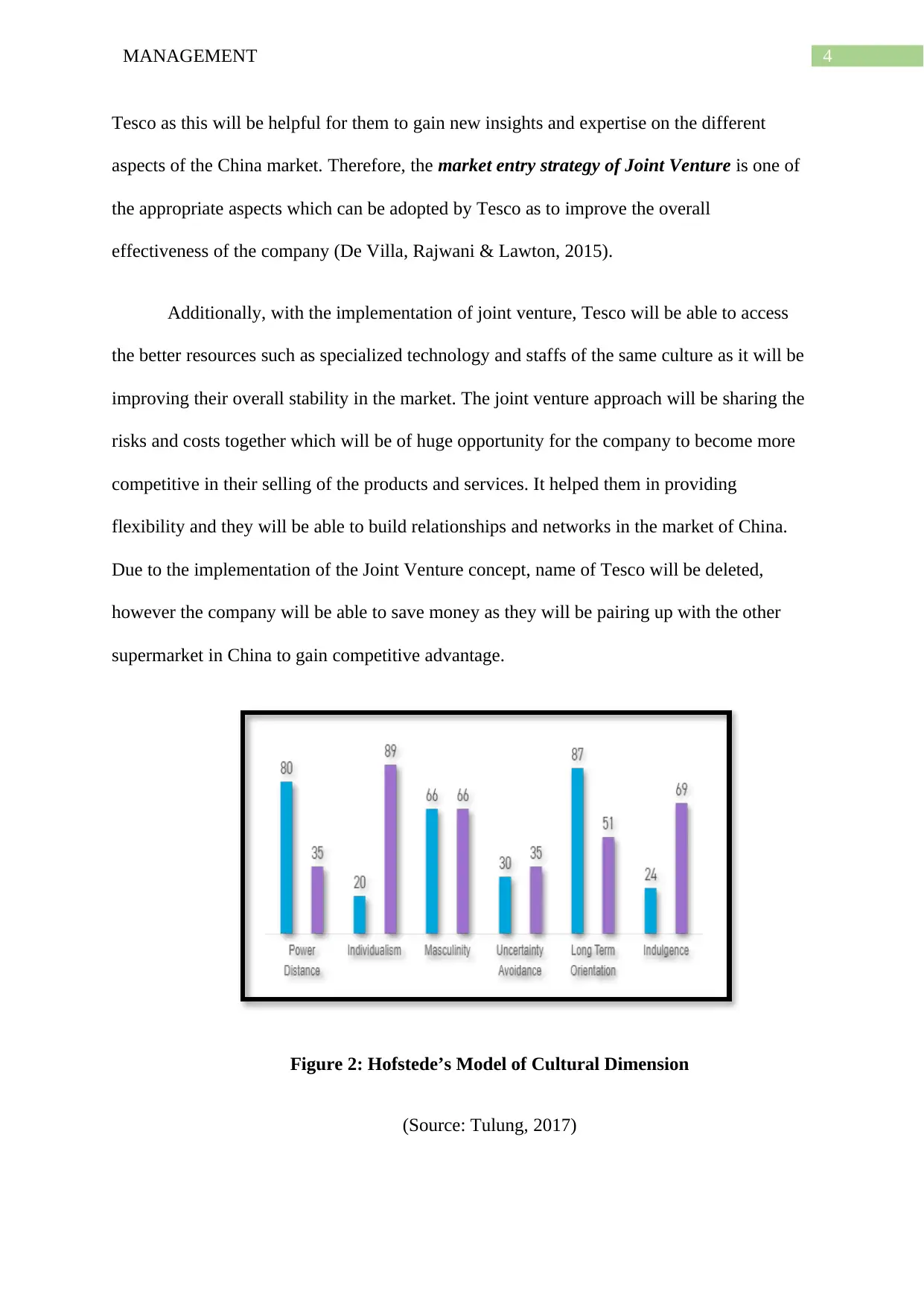
4MANAGEMENT
Tesco as this will be helpful for them to gain new insights and expertise on the different
aspects of the China market. Therefore, the market entry strategy of Joint Venture is one of
the appropriate aspects which can be adopted by Tesco as to improve the overall
effectiveness of the company (De Villa, Rajwani & Lawton, 2015).
Additionally, with the implementation of joint venture, Tesco will be able to access
the better resources such as specialized technology and staffs of the same culture as it will be
improving their overall stability in the market. The joint venture approach will be sharing the
risks and costs together which will be of huge opportunity for the company to become more
competitive in their selling of the products and services. It helped them in providing
flexibility and they will be able to build relationships and networks in the market of China.
Due to the implementation of the Joint Venture concept, name of Tesco will be deleted,
however the company will be able to save money as they will be pairing up with the other
supermarket in China to gain competitive advantage.
Figure 2: Hofstede’s Model of Cultural Dimension
(Source: Tulung, 2017)
Tesco as this will be helpful for them to gain new insights and expertise on the different
aspects of the China market. Therefore, the market entry strategy of Joint Venture is one of
the appropriate aspects which can be adopted by Tesco as to improve the overall
effectiveness of the company (De Villa, Rajwani & Lawton, 2015).
Additionally, with the implementation of joint venture, Tesco will be able to access
the better resources such as specialized technology and staffs of the same culture as it will be
improving their overall stability in the market. The joint venture approach will be sharing the
risks and costs together which will be of huge opportunity for the company to become more
competitive in their selling of the products and services. It helped them in providing
flexibility and they will be able to build relationships and networks in the market of China.
Due to the implementation of the Joint Venture concept, name of Tesco will be deleted,
however the company will be able to save money as they will be pairing up with the other
supermarket in China to gain competitive advantage.
Figure 2: Hofstede’s Model of Cultural Dimension
(Source: Tulung, 2017)
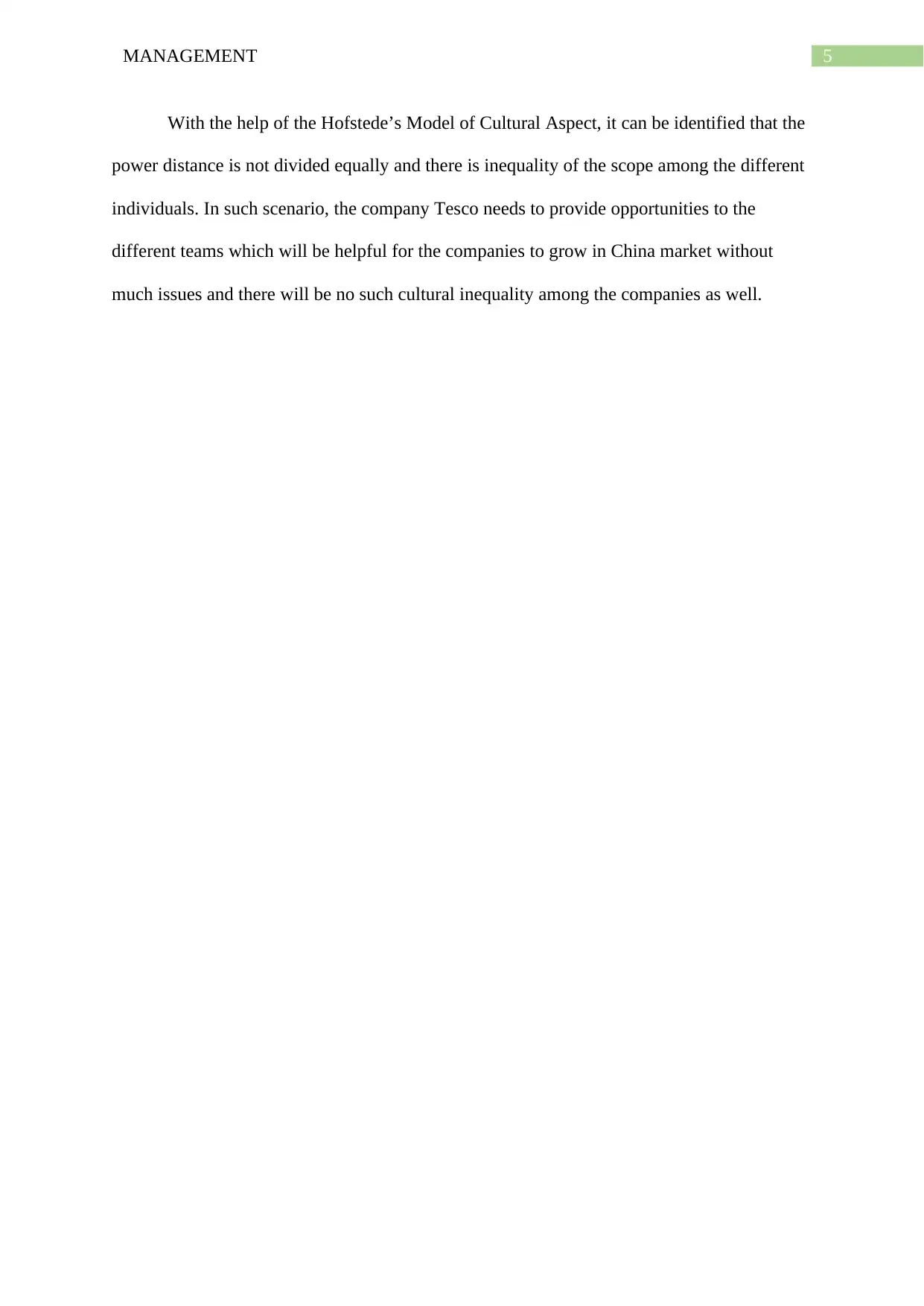
5MANAGEMENT
With the help of the Hofstede’s Model of Cultural Aspect, it can be identified that the
power distance is not divided equally and there is inequality of the scope among the different
individuals. In such scenario, the company Tesco needs to provide opportunities to the
different teams which will be helpful for the companies to grow in China market without
much issues and there will be no such cultural inequality among the companies as well.
With the help of the Hofstede’s Model of Cultural Aspect, it can be identified that the
power distance is not divided equally and there is inequality of the scope among the different
individuals. In such scenario, the company Tesco needs to provide opportunities to the
different teams which will be helpful for the companies to grow in China market without
much issues and there will be no such cultural inequality among the companies as well.
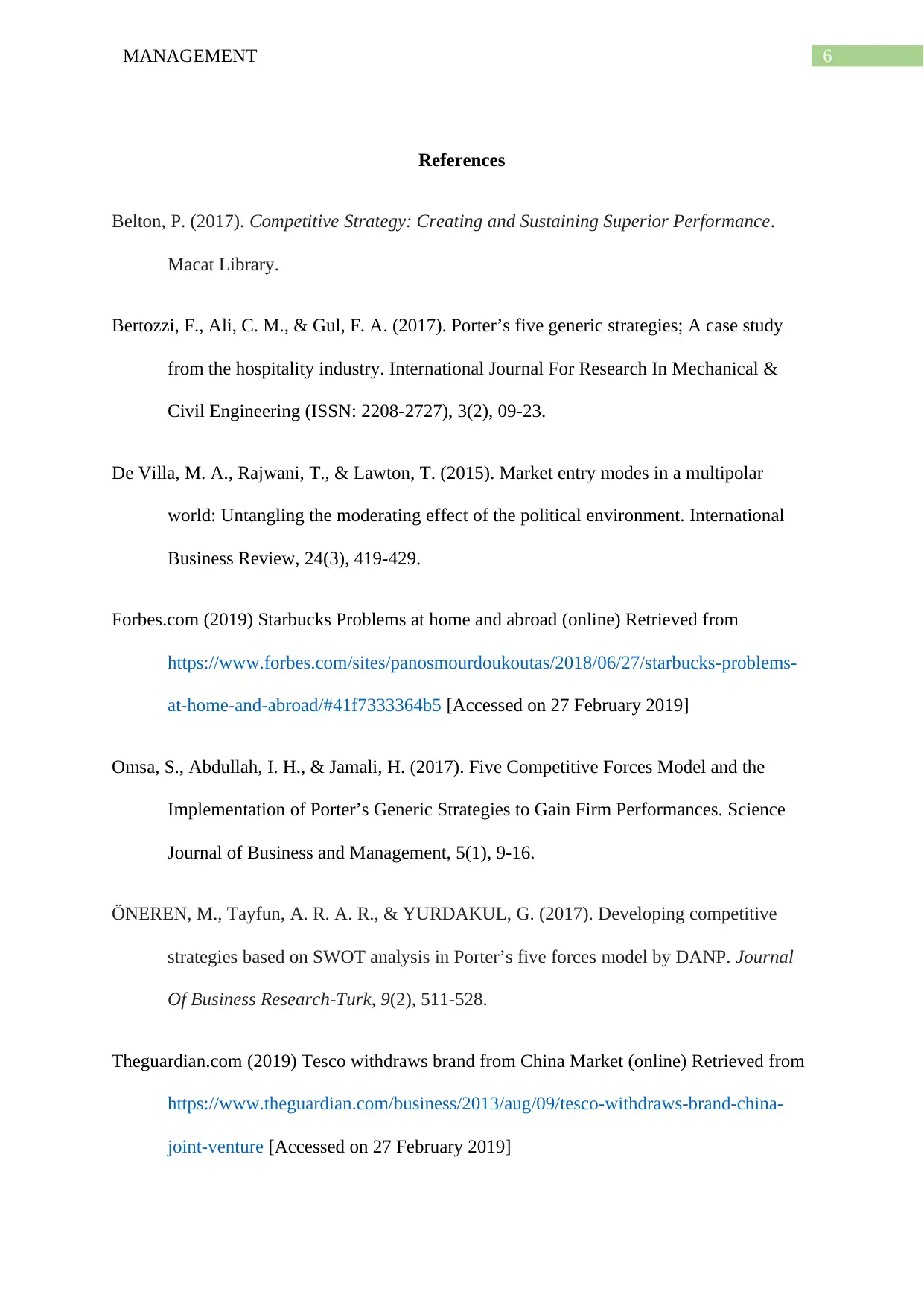
6MANAGEMENT
References
Belton, P. (2017). Competitive Strategy: Creating and Sustaining Superior Performance.
Macat Library.
Bertozzi, F., Ali, C. M., & Gul, F. A. (2017). Porter’s five generic strategies; A case study
from the hospitality industry. International Journal For Research In Mechanical &
Civil Engineering (ISSN: 2208-2727), 3(2), 09-23.
De Villa, M. A., Rajwani, T., & Lawton, T. (2015). Market entry modes in a multipolar
world: Untangling the moderating effect of the political environment. International
Business Review, 24(3), 419-429.
Forbes.com (2019) Starbucks Problems at home and abroad (online) Retrieved from
https://www.forbes.com/sites/panosmourdoukoutas/2018/06/27/starbucks-problems-
at-home-and-abroad/#41f7333364b5 [Accessed on 27 February 2019]
Omsa, S., Abdullah, I. H., & Jamali, H. (2017). Five Competitive Forces Model and the
Implementation of Porter’s Generic Strategies to Gain Firm Performances. Science
Journal of Business and Management, 5(1), 9-16.
ÖNEREN, M., Tayfun, A. R. A. R., & YURDAKUL, G. (2017). Developing competitive
strategies based on SWOT analysis in Porter’s five forces model by DANP. Journal
Of Business Research-Turk, 9(2), 511-528.
Theguardian.com (2019) Tesco withdraws brand from China Market (online) Retrieved from
https://www.theguardian.com/business/2013/aug/09/tesco-withdraws-brand-china-
joint-venture [Accessed on 27 February 2019]
References
Belton, P. (2017). Competitive Strategy: Creating and Sustaining Superior Performance.
Macat Library.
Bertozzi, F., Ali, C. M., & Gul, F. A. (2017). Porter’s five generic strategies; A case study
from the hospitality industry. International Journal For Research In Mechanical &
Civil Engineering (ISSN: 2208-2727), 3(2), 09-23.
De Villa, M. A., Rajwani, T., & Lawton, T. (2015). Market entry modes in a multipolar
world: Untangling the moderating effect of the political environment. International
Business Review, 24(3), 419-429.
Forbes.com (2019) Starbucks Problems at home and abroad (online) Retrieved from
https://www.forbes.com/sites/panosmourdoukoutas/2018/06/27/starbucks-problems-
at-home-and-abroad/#41f7333364b5 [Accessed on 27 February 2019]
Omsa, S., Abdullah, I. H., & Jamali, H. (2017). Five Competitive Forces Model and the
Implementation of Porter’s Generic Strategies to Gain Firm Performances. Science
Journal of Business and Management, 5(1), 9-16.
ÖNEREN, M., Tayfun, A. R. A. R., & YURDAKUL, G. (2017). Developing competitive
strategies based on SWOT analysis in Porter’s five forces model by DANP. Journal
Of Business Research-Turk, 9(2), 511-528.
Theguardian.com (2019) Tesco withdraws brand from China Market (online) Retrieved from
https://www.theguardian.com/business/2013/aug/09/tesco-withdraws-brand-china-
joint-venture [Accessed on 27 February 2019]
Paraphrase This Document
Need a fresh take? Get an instant paraphrase of this document with our AI Paraphraser
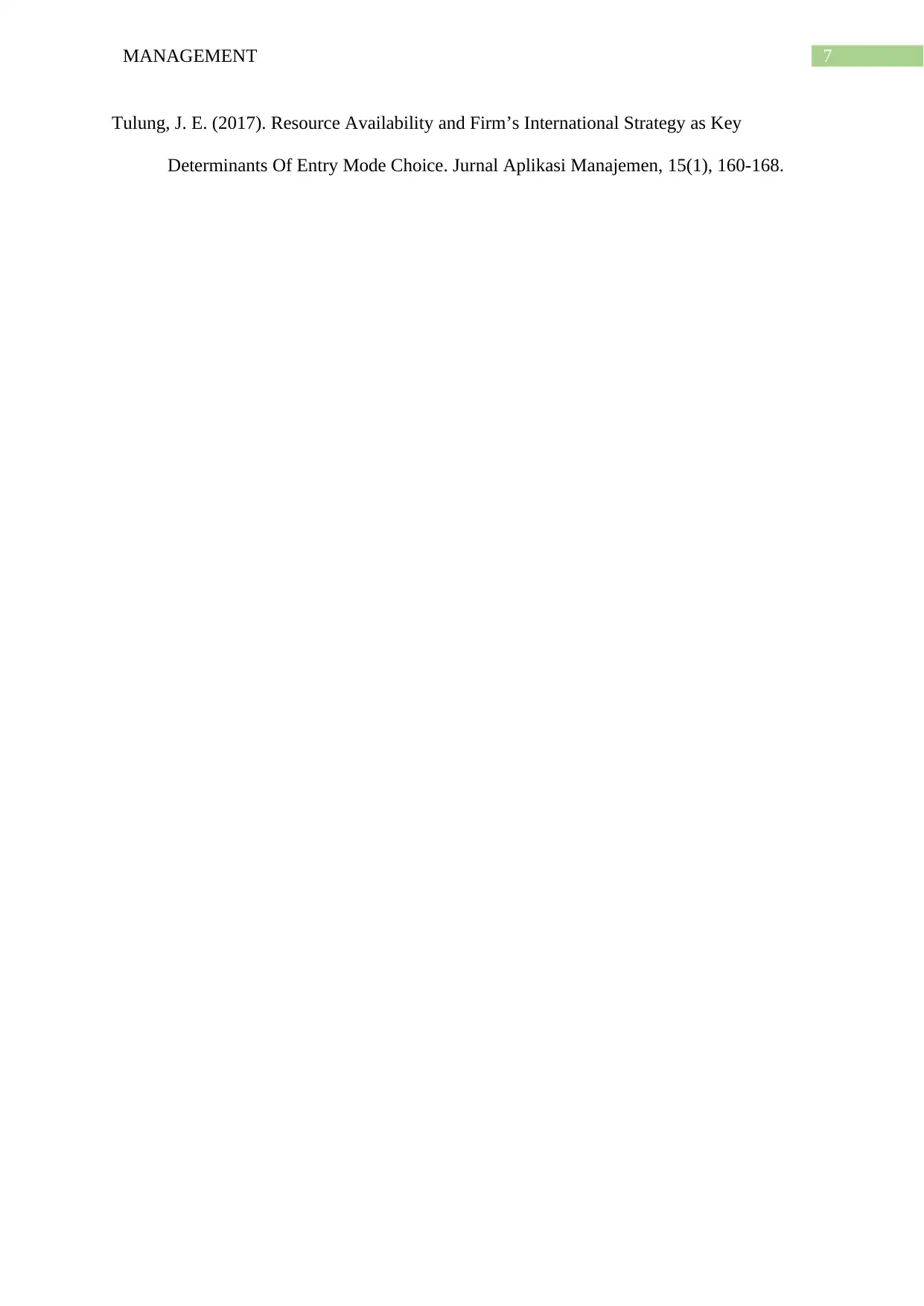
7MANAGEMENT
Tulung, J. E. (2017). Resource Availability and Firm’s International Strategy as Key
Determinants Of Entry Mode Choice. Jurnal Aplikasi Manajemen, 15(1), 160-168.
Tulung, J. E. (2017). Resource Availability and Firm’s International Strategy as Key
Determinants Of Entry Mode Choice. Jurnal Aplikasi Manajemen, 15(1), 160-168.
1 out of 8
Related Documents
Your All-in-One AI-Powered Toolkit for Academic Success.
+13062052269
info@desklib.com
Available 24*7 on WhatsApp / Email
![[object Object]](/_next/static/media/star-bottom.7253800d.svg)
Unlock your academic potential
© 2024 | Zucol Services PVT LTD | All rights reserved.




